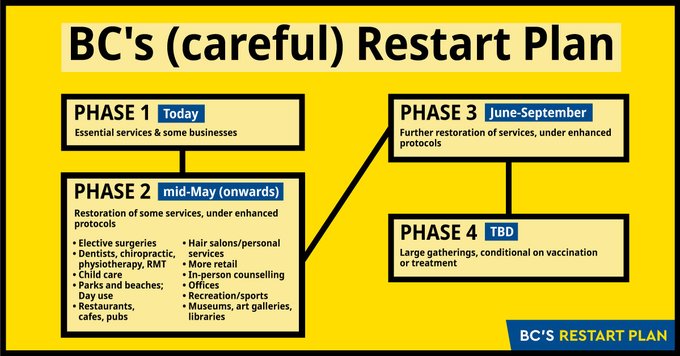
Overview
As of May 1, 2020, more than 2,100 British Columbians have tested positive for COVID-19 and more than 100 people have died.
As the pandemic hit B.C., we asked British Columbians to do their part and they took action to stay home and help flatten the curve. With each day, the rate of growth in COVID-19 cases has steadily declined and more than 1,350 people have recovered. And we have the lowest mortality of any jurisdiction in North America with a population of more than five million.
FIGURE 1: Cumulative diagnosed COVID-19 case rates by select countries
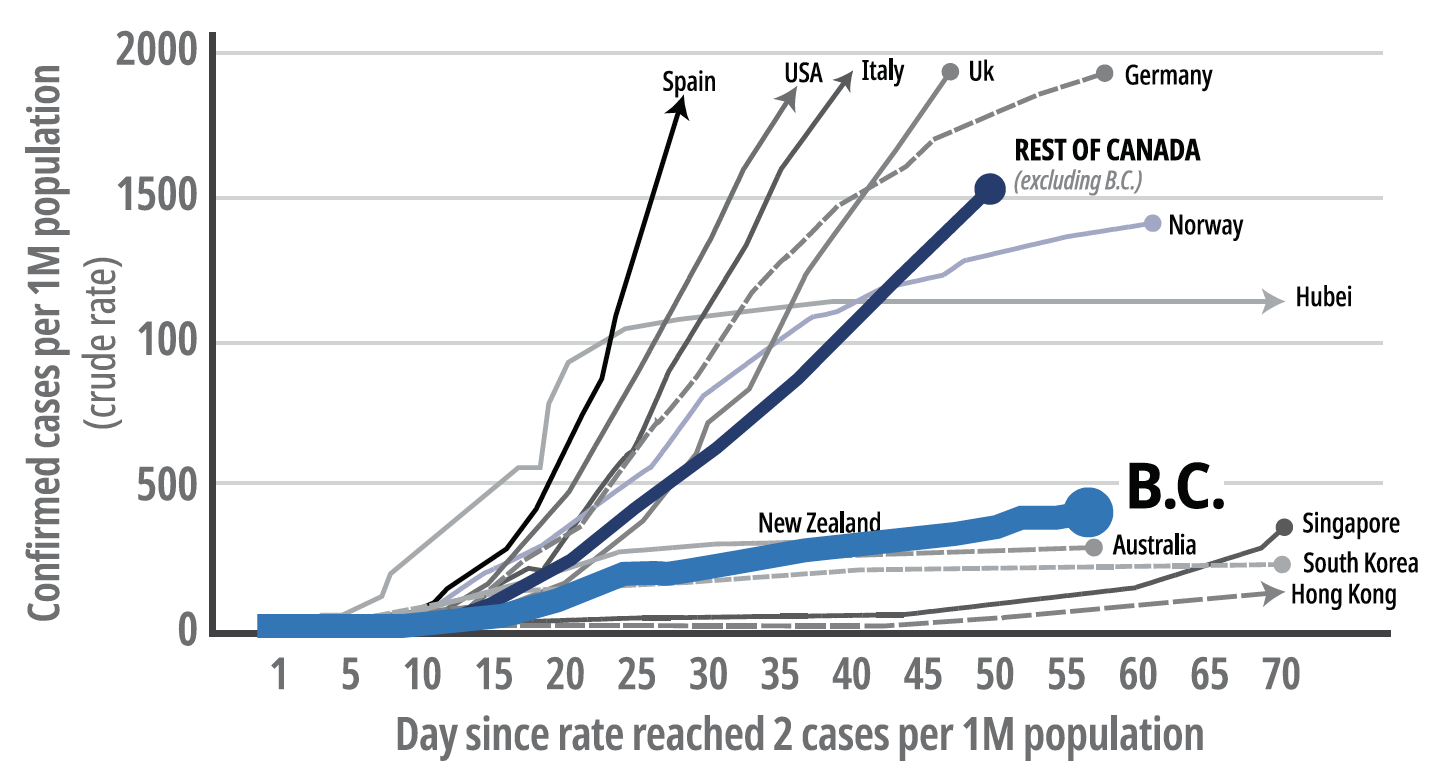 From the outset, the focus of B.C.’s efforts has been on protecting people by slowing the rate of transmission.
From the outset, the focus of B.C.’s efforts has been on protecting people by slowing the rate of transmission.
BC’s Restart Plan is the first in a series of steps that we will take together to protect people and ensure that our province can come back from COVID-19 stronger than before.
Protective Measures We’ve Taken in B.C. Have Made a Difference
Around the world, governments have taken different approaches to try to bend and flatten the curve of transmission — from complete lockdowns to quarantines and varying intensities of physical distancing.
From the outset, B.C. established clear guidance, transparency and an evidence-based approach as hallmarks of our fight against COVID-19.
Protective measures B.C. has taken have included:
- Providing physical distancing and hygiene guidelines for people, businesses and essential services to follow
- Banning mass gathering of more than 50 people to reduce the risk of outbreaks
- Closing bars, dine-in service at restaurants, and personal service operators, like barbers and dentists, to reduce the risk of transmission
- Reducing in-classroom learning and child care
- Requiring travellers to develop and stick to a 14-day isolation plan when arriving in B.C. from abroad
- Restricting visitors to health care and assisted living facilities to protect some of our most vulnerable people
- Postponing non-urgent and elective surgeries while maintaining urgent and emergency procedures
Working together we’ve made a lot of progress. These protective measures and restrictions have directly saved lives, but we also know that the public health benefit has come at some expense, including the economic, social and personal well-being of many British Columbians.
The Next Stage of Our Challenge
B.C. has made extensive use of modelling and planning in our decision-making process, including the Oxford Stringency Index.
While mathematical models of pandemics are just that – models – B.C.’s modelling has accurately predicted several key indicators in our efforts to flatten the pandemic curve, including trends in hospitalization rates, visits to ICUs, and recently confirmed infections.
Data showing the movements of British Columbians indicates that, to do their part to flatten transmission, people in the province have reduced their social interactions and contact with others to about 30% of normal. By sticking with the existing protective measures, we can expect a further decline in the rate of new infections.
FIGURE 2: Contacts stay at approximately 30% (70% physical distancing)
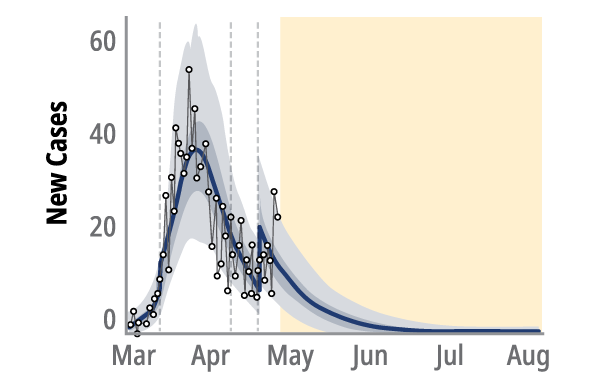
The same mathematical modelling indicates a return to pre-COVID-19 normal in our social interactions would have a disastrous effect, dramatically increasing infections, undoing our combined efforts and putting people at risk. Even at 80%, there could be a significant spike in transmissions.
FIGURE 3: Contacts increase to 100% (return to pre-COVID-19)
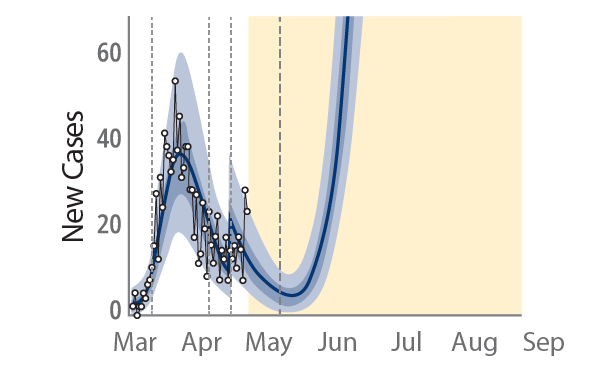
FIGURE 4: Contacts increase to 80% (20% physical distancing)
However, the modelling does show we can increase our rate of contact to about 60% of pre-COVID-19 normal, while maintaining a flat rate of transmission. In other words, we can double the amount of social contacts we have now and still flatten the curve.
FIGURE 5: Contacts increase to 60% (40% physical distancing)
Medical professionals speculate it could be 12 to 18 months before a vaccine is developed.
Until then, the challenge for all British Columbians will be modifying our behaviour and protective measures cautiously to allow for greater interactions without putting the health of our loved ones, friends and neighbours at risk.
How We’ll Keep Transmission Low
What the New Normal Means for You
B.C.’s progress in the fight against COVID-19 is a direct result of the sacrifices and decisions that we have all made. To continue to protect seniors and at risk people and ensure that our health care system can respond to this dangerous virus, means that we all have to keep doing our part – at home, in the community and at work.
- Stay at home and keep a safe distance from family when you have cold or flu symptoms, including:
- Coughing
- Sneezing
- Runny nose
- Sore throat
- Fatigue
- No handshaking or hugs outside of your family
- Practice good hygiene, including:
- Regular hand washing
- Avoiding touching your face
- Covering coughs and sneezes
- Disinfect frequently touched surfaces
- Keep physical distancing, as much as possible when in the community and where not possible, consider using a non-medical mask or face covering
And in personal settings when you’re seeing friends and family who don’t live with you:
- Only get together in small groups of around 2 to 6 people and keep a physical distance
- Stay home and away from others if you have cold or flu symptoms
If you are at greater risk (over the age of 60 or with underlying medical conditions), be informed of your risk, think through your risk tolerance and take extra precautions.
What the New Normal Means for Employers and Public Institutions
The risk of transmission at busy workplaces and other institutions is a direct function of two variables: the number of contacts (the number of people present at the same time) and the contact intensity (the type of contact ie. close or distant and the length of contact ie. brief or prolonged). These are factors that we can rate as low, medium and high risks.
FIGURE 6: Reducing transmission
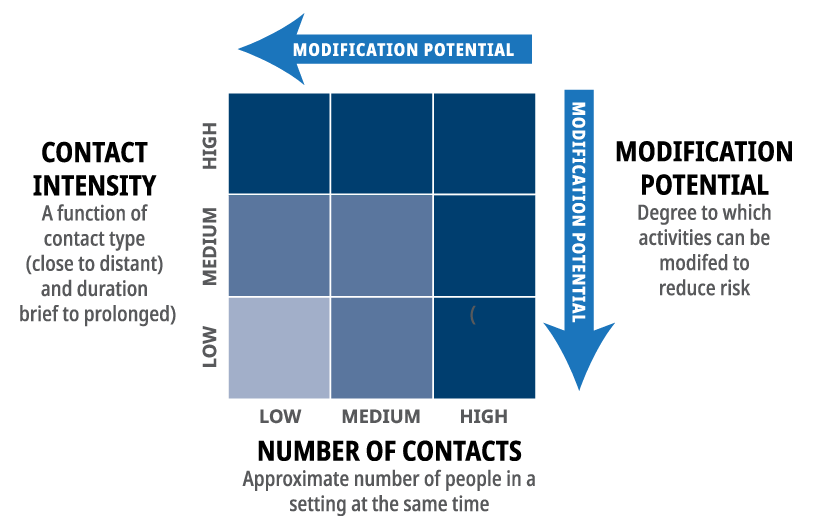
Based on these factors, steps can be taken to reduce the risk, including:
- Physical distancing measures – measures to reduce the density of people
- Engineering controls – physical barriers (like plexiglass at checkouts) or increased ventilation
- Administrative controls – clear rules and guidelines
- Personal protective equipment – like the use of non-medical masks
These modifications and controls, combined with the following measures, can reduce the risk of transmission.
- Create clear workplace policies that ensure people with cold or flu symptoms do not come to work
- Implement sick day policies that allow people to be off or work safely from home when they are ill or have symptoms of a cold or flu
- Provide work from home options, when possible, to reduce contact intensity. When it’s not an option, consider measures such as staggered shifts and virtual meetings as much as possible
- Implement strategies that reduce the number and intensity of contacts – from greater use of non-medical masks to more checkouts and increased shopping hours
- Clean “high-touch” areas in workplaces and retail outlets frequently and provide hand sanitizer at entrances
- Focus on higher-risk employees including those over the age of 60 and those with underlying medical conditions – from more flexible hours, to work from home options and workspace accommodation
Additional measures specific to various organizational settings are being developed. More will be created as various sectors are engaged and industry or sector wide norms are adopted and required.
For employers and retailers seeking detailed information, please refer to the BC COVID-19 Go-Forward Management Strategy (PDF, 634KB) and the BC COVID-19 Go-Forward Management Checklist (PDF, 320KB), as well as resources from WorkSafeBC.
How We’ll Start Getting People Back to Work
Unlike many other places that imposed strict “lockdown” policies, B.C.’s approach was to require safe operation of a broad range of services designated as essential services, to protect our health care system and maintain access to key services and supplies. Many non-essential businesses remained open, provided they could operate safely.
A Safer Restart with WorkSafeBC
Like essential services during the pandemic, all employers must demonstrate that they can operate safely. In fact, all employers are required under the Workers Compensation Act to ensure the safety of their employees at work.
As local businesses, non-profits and organizations plan for their restart, WorkSafeBC is here to help.
WorkSafeBC will work with industry associations to ensure the direction and guidance they provide to their members meets the requirements set out by the Provincial Health Officer.
WorkSafeBC will work with employers and workers through educational materials, consultation, and workplace inspections to help them restart safely.
Employers will be required to:
- Review the new Health and Safety Guidelines, best practices and other resources from WorkSafeBC
- Adapt these materials into appropriate COVID-19 Safe Plans for your workplace
Sectors that have operated during the pandemic may need to update their COVID-19 Safe Plans to fit with updated Health and Safety Guidelines, best practices and resources.
For resources, visit the WorkSafeBC website or call WorkSafeBC’s Prevention Information Line at 1-888-621-7233.
A Careful Restart
B.C.’s restart will be a careful, step-by-step process to ensure all of our combined efforts and sacrifices are not squandered.
For the different organizational sectors to move forward, they will be asked to develop enhanced protocols aligned with the Public Health and Safety Guidelines. A cross-ministry committee of deputy ministers will monitor the process and ensure overall alignment with the Public Health and Safety Guidelines and WorkSafeBC. The Provincial Health Officer will continue to provide input and advice as needed throughout the review process.
In some instances, this will require consideration by the Provincial Health Officer of lifting or modifying existing orders before certain businesses re-open. Businesses and organizations that are not covered by a Provincial Health Officer order may re-open or continue to operate but they will be expected to adopt and implement sector safety plans are they are finalized.
Phase 1
Where we are today
Essential Services Operating During COVID-19
- Essential health and health services
- Law enforcement, public safety, first responders and emergency response personnel
- Vulnerable population service providers
- Critical infrastructure
- Food and agriculture service providers
- Transportation
- Industry and manufacturing
- Sanitation
- Communications and information technology
- Financial institutions
- Other non-health essential service providers
Industries that were designated as essential services developed safe operation plans in consultation with WorkSafeBC and in compliance with the public health orders issued by the Provincial Health Officer.
As a result, B.C.’s economy has continued to operate in ways other provinces haven’t. But it’s undeniable that local businesses have suffered.
Many businesses closed for other reasons, including reduced demand, such as in the retail, hospitality and export industries. Others closed to do their part in helping to flatten the curve, protecting their customers and employees.
To help these businesses and other organizations get back on their feet, we need workplace practices that ensure British Columbians feel safe, whether they are returning to work or going out as a customer. That means employers will need to engage with their employees to find the right solutions and consider the concerns and needs of their customers.
Phase 2
Mid-May onwards
Under enhanced protocols:
- Restoration of health services
- Re-scheduling elective surgery
- Medically related services:
- Dentistry, physiotherapy, registered massage therapy, and chiropractors
- Physical therapy, speech therapy, and similar services
- Retail sector
- Hair salons, barbers, and other personal service establishments
- In-person counselling
- Restaurants, cafes, and pubs (with sufficient distancing measures)
- Museums, art galleries, and libraries
- Office-based worksites
- Recreation and sports
- Parks, beaches, and outdoor spaces
- Child care
Phase 3
June to September
If transmission rates remain low or in decline, under enhanced protocols:
- Hotels and Resorts (June 2020)
- Parks – broader reopening, including some overnight camping (June 2020)
- Film industry – beginning with domestic productions (June/July 2020)
- Select entertainment – movies and symphony, but not large concerts (July 2020)
- Post-secondary education – with mix of online and in-class (September 2020)
- K-12 education – with only a partial return this school year (September 2020)
Phase 4
To be determined
Conditional on at least one of the following; wide vaccination, “community” immunity, broad successful treatments:
- Activities requiring large gatherings, such as:
- Conventions
- Live audience professional sports
- Concerts
- International tourism
The timing of a safe restart of night clubs, casinos and bars is a more complicated consideration. As with other sectors, industry associations will be expected to develop safe operations plans, for review, that are in keeping with Public Health and Safety Guidelines, as well as WorkSafeBC.
Resources to assist businesses and sectors as they restart their activities including new Health Guidelines and Checklists are available from WorkSafeBC.
Some Next Steps to Make Life a Little Easier
Reopening our Parks
Reopening B.C.’s iconic parks will come in rapid stages. Our priority is providing safe access and services to people across the province while maintaining the safety of staff and park operators.
BC Parks and Recreation Sites and Trails BC will reintroduce services in keeping with direction from the Provincial Health Officer.
Parks Reopen
May 14, 2020
Beginning on May 14, 2020, those BC Parks, recreation sites and trails that can accommodate physical distancing will reopen for day use only.
- This will include day-use sites and protected areas
Parks and recreation sites that can safely provide existing service levels, such as garbage disposal and washroom facilities, will do so.
- These facilities will be cleaned more frequently
Some areas and facilities remain closed, including playgrounds, picnic shelters and visitor centres.
- Check the BC Parks website for the most up to date information
Camping Resumes
June 1, 2020
Camping at provincial parks and recreation sites will reopen June 1, 2020, with some exceptions.
- The BC Parks website will carry information about the status of camping in provincial parks
Reopening our Schools
As COVID-19 spread, governments everywhere took action to reduce in the classroom learning.
For most British Columbians with young children, this meant having to stay at home to look after their kids. While many workplaces have made work-from-home accommodations, that hasn’t been an option for everyone.
Our schools and educators rose to the challenge with online instruction and resources to keep our kids learning, but this placed a heavy burden on parents to support their kids as they learned at home.
We know there is no substitute for in-class instruction — and an important step toward our recovery is getting kids back into the classroom, so parents can get back into the workplace.
Initial health data indicates children are less affected than adults by the COVID-19 virus. Public health staff and officials will continue to review the health data. And the Ministry of Education and school divisions all around B.C. are reviewing options to allow for a safe return to school.
An announcement on a phased approach to resuming in-class instruction will be made in the coming weeks.
This will not be a return to normal. With weeks left in the school year, we anticipate many kids will not return to the classroom until September.
But we are also exploring ways to safely get some kids back to school before the summer, to allow more parents to return to work. How these changes unfold are the focus of intensive discussion among Ministry of Education officials, school trustees, the BC Teachers’ Federation, CUPE, and other education sector partners.
For more information on protective measures that will be required of schools and post-secondary institutions, please refer to the BC COVID-19 Go-Forward Management Strategy (PDF, 634KB) and the BC COVID-19 Go-Forward Management Checklist (PDF, 320KB).
Reopening Child Care & Summer Camps
Summer camps and child care services give our kids the chance to explore their interests and develop physically, mentally and emotionally. They also allow parents to continue to work knowing that their children are being well taken care of.
Like all businesses, child care centres and camps will need to take additional precautions to maintain the health and safety of their employees and the children they are caring for. For many child care centres that operated as essential services during the pandemic, they have already adapted and are operating safely. But reopening more child care centres will be a key part of getting more parents back to work.
The basics will include routine daily screening of staff and kids; frequent cleaning; and ensuring staff and children who have cold or flu symptoms do not attend child care or summer camps.
But these sectors will also be required to review and work through new practices in their specific sectoral standards such as the Child Care Setting Practice Standards.
For more information on protective measures that will be required of day cares and summer camps, please refer to the BC COVID-19 Go-Forward Management Strategy (PDF, 634KB) and the BC COVID-19 Go-Forward Management Checklist (PDF, 320KB).
Expanding Public Transit Services
Many of us know what it means to ride on a tightly packed bus or SkyTrain. Before the pandemic, physical distancing was not always an option.
British Columbians were quick to act on direction from the Provincial Health Officer, including staying home and avoiding unnecessary trips outside the home. This made riding public transit easier for people working in essential services.
As B.C. begins our restart and more people gradually return to the workplace, there will be greater pressures on our public transportation networks to help people get around safely.
Ensuring operators and passengers can safely use public transit is critical. Enhanced health and safety precautions, including frequent cleaning; wearing non-medical masks for riders and staff; use of plexiglass or physical barriers where possible for drivers; and staying home when sick will be a part of the new normal for the foreseeable future.
The safe operation of public transit is a priority for all British Columbians. Over the coming weeks, we will be working with our transit agencies on more detailed plans to gradually restore service levels as restrictions begin to lift – both to help people get around and to ensure people can continue to respect physical distancing.
How We’ll Keep Taking Care of Each Other
Supporting Families & Businesses
When the pandemic hit, the governments of British Columbia and Canada came together to identify critical supports for people, businesses and community organizations. The urgency of COVID-19 made it critical to plan, announce and deliver on vital supports for people and businesses across our province in record time.
Supports for Individuals & Families
These supports have helped people stay in their homes, support their families and make ends meet. But we know that the recovery will take longer for some British Columbians than others. Working with the government of Canada, local leaders and community organizations, we will be there to help them get through this.
Protecting Patients & Our Health Care System
Over the last three years, B.C. implemented an ambitious strategy to increase patient access to surgeries, expand priority programs and reduce wait times.
The strategy was working, providing 35,000 more people with access to critical surgery. Hip and knee replacement wait times were reduced by 11% and dental surgery wait times were reduced by 6.8% with plans to expand both.
COVID-19 has wiped-out that progress. In March, the province reluctantly cancelled elective and non-urgent surgeries – while still performing more than 8,200 urgent or emergency procedures. This resulted in the cancellation of thousands of scheduled elective surgeries, but it was necessary to ensure that British Columbians with COVID-19 would have access to hospital beds.
Beginning on May 18, 2020, elective and non-urgent surgeries will resume.
Beyond restarting elective surgeries, we will make new investments in public health and the BC Centre for Disease Control to ensure B.C. is able to undertake timely testing, case tracking and contact tracing, while also building our hospital capacity to quickly respond to a new outbreak.
Working with Indigenous, Rural & Remote Communities
We know that people living in rural, remote and Indigenous communities have unique challenges in accessing the care that they need. A new collaborative framework will help ensure that people living in these in communities have access to the care and unique supports they need.
The framework outlines immediate actions to improve health care services including:
- Improved medical transportation options to larger centres, including flight and ambulance
- Housing options for people looking to self-isolate near their families while remaining in their home communities
- New and faster COVID-19 testing technology
- Culturally safe contact tracing that respects privacy in small communities
- Access to Virtual Doctor of the Day, a program that connects First Nations members and their families in remote communities to a doctor or nurse practitioner using videoconferencing
- Options for accommodation near larger centres with more medical services
- Increased mental-health supports in communities
Local leaders will determine how these services will operate in their communities with priority being given to ensuring residents can make informed decisions about how they receive care.
The Little Things Make a Big Difference
It will be a while before COVID-19 is behind us. Until then restrictions on large gatherings and international travel will remain. But some things will become a little easier. Over time, our parks, schools, child care centres and camps will reopen. Neighbourhood stores and restaurants will reopen too.
Guidelines will be in place for these businesses and organizations to ensure your safety and the safety of your loved ones. We’re not through this yet, but there are important things you can do to protect you and your loved ones, neighbours and colleagues. The little things make a big difference.
- Stay informed, be prepared and follow public health advice
- Practice good hygiene
- Frequent hand washing
- Avoid touching face
- Cough into your sleeve
- Disinfect frequently touched surfaces
- Stay at home and away from others if you’re feeling ill
- Don’t go to school or work sick
- Maintain physical distancing outside your household
- No handshaking or hugging
- Small numbers of contacts
- Keep a safe distance
- Clean your home and workspace more often
- Consider using non-medical masks when physical distancing isn’t possible
- On transit
- Shopping
Together, we can take these actions to keep the curve flat, while doing more to improve our personal well-being, restart our economy and strengthen our connections in our communities.
